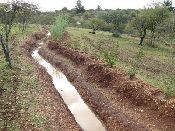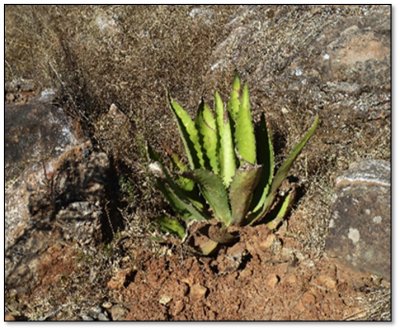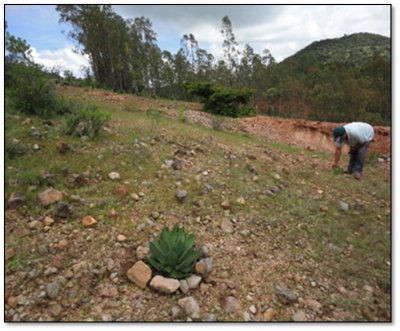|
Agave intercropping: experimental results and conclusions |
 |
|
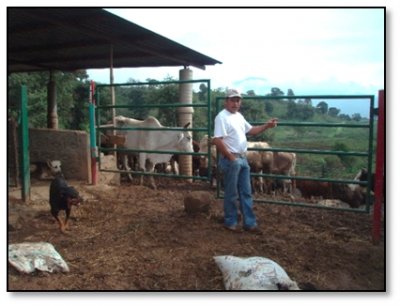 |
In the Cointzio basin, land degradation is mainly due to free grazing of cows. To avoid this, a global solution must be searched and must be adapted to differentenvironmental situations. Due to the critical economic situation of farmers, men and women can act only with subsidies (local projects), managed by political authorities. |
The Cointzio basin has different kinds of soil erosion due to the type of climate (temperate semi-humid with a 6 months rainy season), soils and geomorphology as well as land uses (some mechanized farming, mainly rainfed agriculture with free grazing cattle, forest, recent avocado plantations). Apart from the land degradation, the downstream effect is the refilling of the Cointzio dam used for drinking water of the capital of Michoacán, as well as occasional severe flooding. One of the techniques tested is the agro-forestry of newly established agave plantations.
Experiment: using agave agroforestry to improve soil cover
|
 |
The degraded lands are planted with local agave for making alcoholic beverage (Mezcal) and fodder production in association with trees in 5 ha of land. The wild agave seeds are planted in different density together with trees. Semi quantitative evaluation of the agave plantation is carried out at the beginning of the rainy season. |
Land remediation of the degraded soil by planting local agave (Agave inaequidens) in combination with trees (agro-forestry) can be used as fodder for cattle consumption and also for the production of Mezcal (alcoholic beverage).
Since agave plantation started recently (2010) in Mexico, no concrete result related to remediation of degraded soil is available. Suggestions to improve the agroforestry are the creating of 4 production centers in the basin of Calabozo-Potrerillos considering the distance between the communities, the soil type, the population size and the territory of communities as follows:
- S. Coapa Rafael, San Rafaelillo, El Bañito, Yerbabuena vieja
- The Maiza, La Yerbabuena, S. Andrés Coapa
- Potrerillos and
- Chihuerio, S. Miguel Coapa
This site number may be reduced according to the available resources but should not be less than 2 sites. In addition, suggestions for seedbed preparation, greenhouse and planting distances are suggested as follows:
| 1. Seedbeds for the Agaves and trees (per site) |
|
a. 1 place of 10 x 10 m for the Agave and another one of 5 x 5 m for trees
b. Appropriate substrate of forest soil with compost earthworms (if possible)
c. Water available for irrigation by gravity
d. Fences against animals
|
| 2. Greenhouses (per site) |
|
a. 1 place of 50 x 50 m (1/4 ha) to 200 000 Agaves and 1 place of 21 x 36 m (1/4 ha) for 60,000 trees.
b. Appropriate substrate of forest soil with compost earthworms (if possible)
c. Water available for irrigation by gravity
d. Fences against animals
e. Nursery with greenhouses involves full-time 2 people per site per year.
|
|
3. Agaves transplantation for soil restoration with native maguey and production (after one year in the greenhouse or directly by transplantation of wild plants)
|
|
a. Planting density maguey: / ha 1.5 * 1.2 m = 2,218 plants
b. Density of planting trees / ha: 3 * 3 m = 1,090 plants.
|
| 4. Transplantation of agaves for living borders |
|
a. Agave planting density on the line every 0.20 cm-= 5 plants / linear meter.
|
No evaluation results were given so this analysis cannot be made.
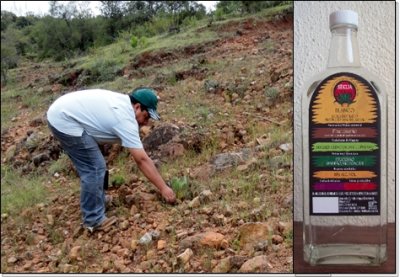 |
Evaluation and effectiveness of the Agave plantation have been discussed during workshops and directly on the field with some farmers. Farmers are interested to do some actions against soil erosion. For the Agave plantation and project, there is a lot of expectation. |
| Agave plantation is a productive undertaking under agroforestry practices. It sustains biodiversity, generate work and remediate soils. |
|

